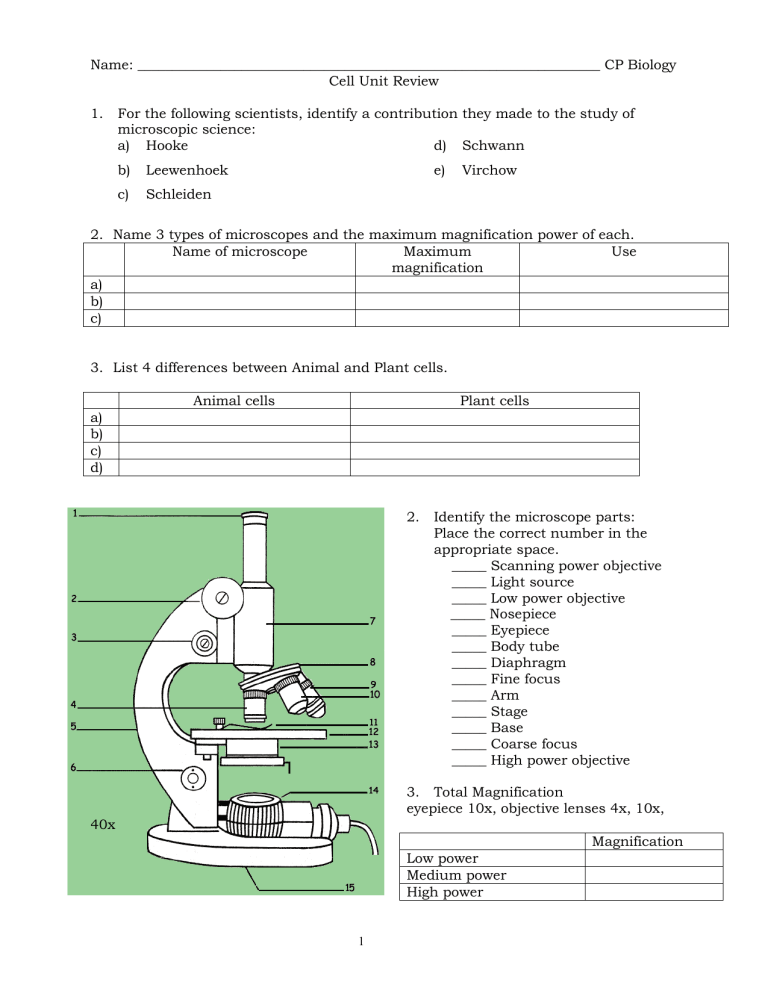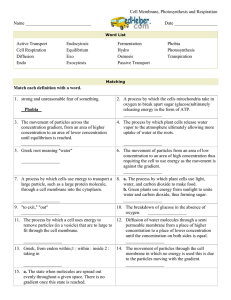
Name: ___________________________________________________________________ CP Biology Cell Unit Review 1. For the following scientists, identify a contribution they made to the study of microscopic science: a) Hooke d) Schwann b) Leewenhoek c) Schleiden e) Virchow 2. Name 3 types of microscopes and the maximum magnification power of each. Name of microscope Maximum Use magnification a) b) c) 3. List 4 differences between Animal and Plant cells. Animal cells Plant cells a) b) c) d) 2. Identify the microscope parts: Place the correct number in the appropriate space. _____ Scanning power objective _____ Light source _____ Low power objective _____ Nosepiece _____ Eyepiece _____ Body tube _____ Diaphragm _____ Fine focus _____ Arm _____ Stage _____ Base _____ Coarse focus _____ High power objective 3. Total Magnification eyepiece 10x, objective lenses 4x, 10x, 40x Magnification Low power Medium power High power 1 4. Cell parts an their function a) Place the correct letter from the diagram beside the proper name on the work list. 3 4 5 1 2 6 7 8 9 10 _____ _____ _____ _____ _____ cell membrane cytoplasm Golgi body nucleus ribosomes _____ nuclear membrane _____ vacuole _____ lysosome _____ endoplasmic reticulum _____ mitochondria b) Is this a plant or animal cell? What organelles are not in this cell that would be in the other type of cell? c) Functions: For the structures you correctly named in a), place that number beside the proper functions below. The part of the cell found outside the nucleus _____ Site of cellular respiration _____ Source of digestive enzymes that break food down _____ Structure that acts as a transport tube for cell products _____ Responsible for storage and secretion of cell products _____ Storage of fluid or products _____ Site of protein biosynthesis _____ Double layered membrane made up of lipids and protein _____ Semipermeable structure that separates one cell from the next _____ Structure which contains DNA _____ 2 5. The cell membrane is made up of: a) ___________________________________ 6. b) ____________________________________ Draw and label the “anatomy” of a Phospholipid a) how does this anatomy explain the lipid bilayer of the membrane? 7. Sketch and label the major components of the cell membrane 8. Concentration gradients can be compared to a river flowing. If products flow ______ the river, we say they move ___________ the concentration gradient. If products move ________ the river, we say they move _____________ the concentration gradient. 9. Passive transport includes 2 types of movement across membranes - they are _____________________ and _________________________. How do they differ? How are they similar? 10. Osmosis can result in 3 types of solutions. Describe each briefly. a) ________________________________________________________ b) ________________________________________________________ c) ________________________________________________________ 11. Active transport is the flow of particles ___________________ the concentration gradient. 12. Some examples of active transport are ____________________ ______________ ________________________. 13. Endocytosis involves the ________________ of particles across a membrane. The engulfing of solid particles is more specifically known as ________________ and the engulfing of liquid particles is known as __________________. 14. The movement of large particles out of a membrane is called ___________________. 3

